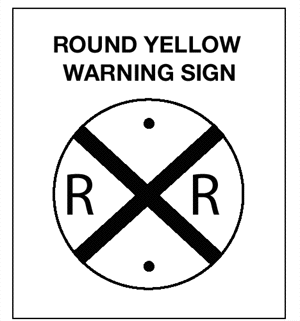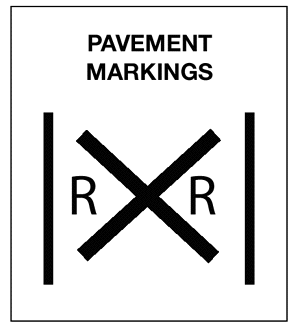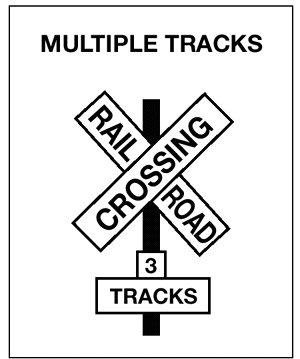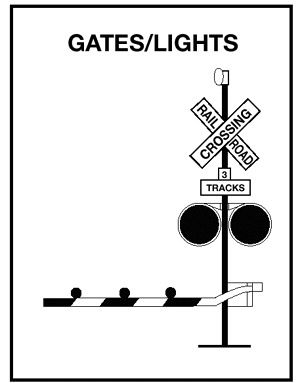Florida CDL Handbook: Railroad-highway Crossings
2. Driving Safely
- 2.1. Vehicle Inspection
- 2.2. Basic Control of Your Vehicle
- 2.3. Shifting Gears
- 2.4. Seeing
- 2.5. Communicating
- 2.6. Controlling Speed
- 2.7. Managing Space
- 2.8. Seeing Hazards
- 2.9. Distracted Driving
- 2.10. Aggressive Drivers/Road Rage
- 2.11. Driving at Night
- 2.12. Driving in Fog
- 2.13. Driving in Winter
- 2.14. Driving in Very Hot Weather
- 2.15. Railroad-highway Crossings
- 2.16. Mountain Driving
- 2.17. Driving Emergencies
- 2.18. Antilock Braking Systems (ABS)
- 2.19. Skid Control and Recovery
- 2.20. Accident Procedures
- 2.21. Fires
- 2.22. Alcohol, Other Drugs, and Driving
- 2.23. Staying Alert and Fit to Drive
- 2.24. Hazardous Materials Rules For All Commercial Drivers
Railroad-highway grade crossings are a special kind of intersection where the roadway crosses train tracks. These crossings are always dangerous. Every such crossing must be approached with the expectation that a train is coming.
2.15.1 - Types of Crossings
Passive Crossings. This type of crossing does not have any type of traffic control device. The decision to stop or proceed rests entirely in your hands. Passive crossings require you to recognize the crossing, search for any train using the tracks and decide if there is sufficient clear space to cross safely. Passive crossings have yellow circular advance warning signs, pavement markings and crossbucks to assist you in recognizing a crossing.
Active Crossings. This type of crossing has a traffic control device installed at the crossing to regulate traffic at the crossing. These active devices include flashing red lights, with or without bells and flashing red lights with bells and gates.
2.15.2 - Warning Signs and Devices
Advance Warning Signs. The round, black-on-yellow warning sign is placed ahead of a public railroad-highway crossing. The advance warning sign tells you to slow down, look and listen for the train, and be prepared to stop at the tracks if a train is coming. See Figure 2.15.
Pavement Markings. Pavement markings mean the same as the advance warning sign. They consist of an "X" with the letters ""RR" and a no-passing marking on two-lane roads. See Figure 2.16.
There is also a no passing zone sign on two-lane roads. There may be a white stop line painted on the pavement before the railroad tracks. The front of the school bus must remain behind this line while stopped at the crossing.

Figure 2-15

Figure 2-16
Crossbuck Signs. This sign marks the grade crossing. It requires you to yield the right-of-way to the train. If there is no white line painted on the pavement, you must stop the bus before the crossbuck sign. When the road crosses over more than one set of tracks, a sign below the crossbuck indicates the number of tracks. See Figure 2.17.
Flashing Red Light Signals. At many highway-rail grade crossings, the crossbuck sign has flashing red lights and bells. When the lights begin to flash, stop! A train is approaching. You are required to yield the right-of-way to the train. If there is more than one track, make sure all tracks are clear before crossing. See Figure 2.18.
Gates. Many railroad-highway crossings have gates with flashing red lights and bells. Stop when the lights begin to flash and before the gate lowers across the road lane. Remain stopped until the gates go up and the lights have stopped flashing. Proceed when it is safe. See Figure 2.18.

Figure 2-17

Figure 2-18
2.15.3 - Driving Procedures
Never Race a Train to a Crossing. Never attempt to race a train to a crossing. It is extremely difficult to judge the speed of an approaching train.
Reduce Speed. Speed must be reduced in accordance with your ability to see approaching trains in any direction, and speed must be held to a point which will permit you to stop short of the tracks in case a stop is necessary.
Don't Expect to Hear a Train. Because of noise inside your vehicle, you cannot expect to hear the train horn until the train is dangerously close to the crossing.
Don't Rely on Signals. You should not rely solely upon the presence of warning signals, gates, or flagmen to warn of the approach of trains. Be especially alert at crossings that do not have gates or flashing red light signals.
Double Tracks Require a Double Check. Remember that a train on one track may hide a train on the other track. Look both ways before crossing. After one train has cleared a crossing, be sure no other trains are near before starting across the tracks.
Yard Areas and Grade Crossings in Cities and Towns. Yard areas and grade crossings in cities and towns are just as dangerous as rural grade crossings. Approach them with as much caution.
2.15.4 - Stopping Safely at Railroad- highway Crossings
A full stop is required at grade crossings whenever:
- The nature of the cargo makes a stop mandatory under state or federal regulations.
- Such a stop is otherwise required by law.
When stopping be sure to:
- Check for traffic behind you while stopping gradually. Use a pullout lane, if available.
- Turn on your four-way emergency flashers.
2.15.5 - Crossing the Tracks
Railroad crossings with steep approaches can cause your unit to hang up on the tracks.
Never permit traffic conditions to trap you in a position where you have to stop on the tracks. Be sure you can get all the way across the tracks before you start across. It takes a typical tractor-trailer unit at least 14 seconds to clear a single track and more than 15 seconds to clear a double track.
Do not shift gears while crossing railroad tracks.
2.15.6 - Special Situations
Be Aware! These trailers can get stuck on raised crossings:
- Low slung units (lowboy, car carrier, moving van, possum-belly livestock trailer).
- Single-axle tractor pulling a long trailer with its landing gear set to accommodate a tandem-axle tractor.
If for any reason you get stuck on the tracks, get out of the vehicle and away from the tracks. Check signposts or signal housing at the crossing for emergency notification information. Call 911 or other emergency number. Give the location of the crossing using all identifiable landmarks, especially the DOT number, if posted.
Check out our Customer Reviews!


